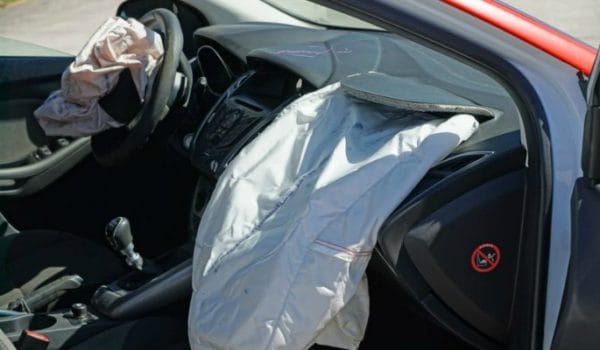Why Car Safety Features Are the No. 1 Reason to Buy a New (or Newish) Car

Car safety features will keep you and yours safe. And they will increase your car’s resale value.
From babes in car seats to new teen drivers to older drivers behind the wheel, the car safety features of today’s new cars are aimed at keeping everyone safe—the people inside the car and the people in other cars.
Car safety was the topic of a wide-ranging panel discussion at the 2017 Women in Automotive conference in Orlando. The panel featured Susan Scarola, who heads the National Foundation for Teen Safe Driving, and our very own Scotty Reiss, co-founder of A Girls Guide to Cars. The session was moderated by Jennifer Newman, editor-in-chief for Cars.com.
Watch the full discussion here:
Live from #WomeninAuto17: chatting cars, safety and women with Scotty Reiss, Jennifer Newman and Susan Scarola
Posted by A Girls Guide to Cars on Monday, July 10, 2017
Exploring Car Safety Features in a Broader Sense
Jennifer, who took the 40-hour training course to become a certified car seat installer, noted that 75 percent of car seats are installed incorrectly. Once the seat is installed, parents don’t want to do it again. That’s one reason features like a second row seat that tilts forward rather than folding flat to allow access to the third row seating are important car safety features. It means parents don’t have to take out the car seat to get someone into the third row, then re-install the car seat.
Still, Scotty said, car safety these days is about more than a quality car seat properly installed.
“This is something the auto industry is tackling in proactive ways. It’s about the safety of kids altogether,” she told the audience.
That includes a host of things, from the quality of the steel used in the car to a GMC feature that reminds drivers they left something in the back seat.

Putting away a cell phone.
Ensuring Teen Drivers Are Safe
We parents are always reminding our kids not to text and drive. But we need to do more, Susan said. We need to model good behavior—from the time kids are old enough to be paying attention, not just once they hit driving age.
“Kids are watching everything we do, not just what we say,” she told the audience.
That includes us not texting and driving. And, perhaps even more importantly, it includes us wearing our seatbelts. Always. That’s because most teens who are seriously injured in car crashes were hurt because they weren’t wearing their seat belts, Susan said.
Modeling good behavior was a corporate challenge, too. “We really had to practice what we preached,” Susan said. “It wasn’t just teen driving. It started to impact a lot of the decisions we made on a corporate level—about having employees in cars talking on phones, about having parties with alcohol.”

Cell phone linking is a car safety feature . Photo by Mary Moore.
Dealing with Those Cell Phone Distractions
Susan’s organization tackles teens and cell phones in a low-tech way and with a sense of humor: It distributes “phone condoms.”
“You put your phone in the condom, and put it away from you—in the trunk or the glove compartment. Some place you can’t see it,” she said.
Scotty likes a higher-tech version of cell phone safety–modern hands-free cell linking technology in which information is displayed on the car’s screen. That means the driver doesn’t have to pick up a phone and look at the small screen to check the navigation or answer a call. Even better, the system can be set to turn off notifications. Unless, of course, Mom is calling.
Getting Help from the Auto Manufacturers
Susan sent a shout-out to Toyota, which has a program aimed at teaching teens and their parents about car safety, driving safety, even minor car maintenance.
“They invite parents and teens into the dealership. It’s not a sales opportunity, but an education opportunity,” she said.
They talk about things like graduated license laws (one of Scotty’s personal favorites) that limit a teen’s ability to, for example, drive late at night before the age of 18. And they teach teens some car basics, such as how to refill the windshield washer fluid—another often unappreciated car safety feature.

He’s ready to drive. You might not be! Photo: Yvonne Jasinski
Why Buying a New(ish) Car is the Best Way to Ensure Car Safety
All of those new car safety features—beeps when you drift into the next lane, automatic braking when you’re too close to the car in front of you—can be disconcerting. Scotty recommends taking the car back to the dealer for further instruction. And keep going back until you understand how everything on the vehicle works. Once you’ve used the car safety features for a while, you can turn them off if you don’t want them. The dealer can show you how to do that as well.
But she recommends buying every car safety feature offered on a vehicle. Not only will it keep you (and your loved ones) safe, it will increase the resale value of your car. And the money you save on car insurance could recoup some of the extra initial investment.
Giving Teen Drivers Safer Cars
Susan said: “When I started to drive at 16, I got the family’s station wagon, which was many, many, many years old. The tradition of passing on the oldest family car to your teen needs to be rethought. When you are buying a car for a teen, you want the safety features there!”
Scotty noted that the same safety features that come in a $100,000 Mercedes Benz also are available in a $20,000 Hyundai.
“Our advice to every buyer is to buy all of the safety features,” Scotty said. “As long as you have the hardware (the sensors), the software can be upgraded for the next 10 years.”

